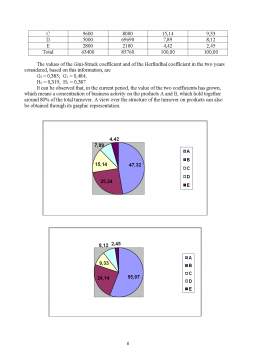Extras din proiect
Chapter I : The analysis of the turnover 2
Chapter II: The analisys of the dynamic of the turnover 3
Chapter III: The structural analysis of the turnover 4
Chapter IV : The factor analysis of the turnover 7
Chapter V: Case Studies 14
- Case study: How Hewitt and Associates retain top talent
- Case study : The importance of turnover in maintaining the employees jobs and viceversa
- Case study: Coca Cola’s turnover
- Case study : Turnover costs
Chapter VI: Fun Facts About The U.S. Government's Massive Debt Problem
The turnover represents the total incomes obtained from the commercial activity of an enterprise over a certain period of time. Within the turnover do not subsume the financial incomes as well as the extraordinary incomes.
The analysis of the turnover has a special importance because it allows the appreciation of the enterprise site assessment in its sector of activity, of its market position, of its abilities to take wind, respectively to develop different activities in a profitable way. At the same time, the modification of the turnover is reflected over the major economical-financial indicators, as well as over the efficiency of the company activities.
From the point of view of the content and its stretching area, the turnover can be seen as: a net turnover (total), a medium turnover, a marginal turnover and a critical turnover.
The net turnover (T) conceives the total volume of a company’s businesses, evaluated in the market prices. It includes the total incomes from the merchandise and products’ sales, the implementation of the works and the service provision over a period of time, as well as the incomes from the subventions of exploitation.
The medium turnover ( ) can be determined in the monoproductive units and it reflects the medium collection per product unit or service.
=
The marginal turnover (Tm) expresses the variation of a company’s collections generated by the increase by one unit of the sales’ volume.
=
The critical turnover (Tmin) represents that certain level of sales at which the sales are covering all the expenses, and the profit is equal to zero. In this case, the minimum turnover can be determined with this relation:
= = ,
where:
FC – total fixed costs;
Lvc – the relative level of variable costs;
VC – total variable costs;
The main objectives of the turnover analysis endorse:
- the analysis of the dynamic of the turnover
- the structural analysis of the turnover
- the factorial analysis of the turnover
- the main consequences of the modification of the turnover
The analysis of the dynamic of the turnover
It has as an objective the separation of the firm's business development tendency in order to take better decisions. Thus, if the turnover is increasing, the company must find new sources for financing the activities. If, on the contrary, the turnover is decreasing there must be found new markets for the products made.
In the process of the analysis the absolute and percentage modification in the size of the turnover from the current period over the one stipulated or from the base period this way:
ΔT = ; ΔT% = ; ΔT = ;
Depending on the size and sign of these changes, there can be made assessments regarding the increase or decrease of the turnover in a company in the period under review. Because the turnover is expressed in current prices, in the period of strong growth in prices it has to be corrected with the inflation index, otherwise the information lose much of their reliability, and the conclusions of the analysis will be deformed. Therefore, it is necessary to determine a real rate of growth of the turnover based on the relation:
ΔT%real =
where: Ip- price index increase
To illustrate the methodology of the analysis at SC APOLO SA the dates are taken from the table 3.6.
Indicators Year basis Current year Modifications
Absolute Percentage
Turnover 63400 85760 22360 35,3
Price index increase 1,00 1,25 - -
The turnover in
comparable prices 63400 68608 5208 8,2
In the current period, the turnover has grown with 22360 million lei, respectively with 35, 3%. Correcting the data with the inflation by comparing the price index, the real growth of the turnover is only 5208 million lei (8,2%), with can be favorable appreciated for the firm.
Bibliografie
The book "Analiza Economico-Financiara" by Lucian Buse, Marian Siminica & Nicu Marcu
http://coba.georgiasouthern.edu//depts/sed/EconLinks.html
http://aggie-horticulture.tamu.edu/extension/newsletters/vpmnews/apr01/art3apr.html
http://www.sashacorp.com/turnframe.html
http://iedconline.org/
Preview document
Conținut arhivă zip
- The Analysis of the Turnover.doc

































